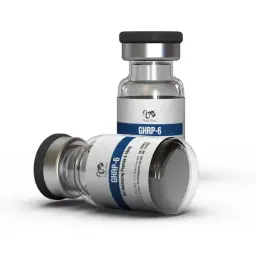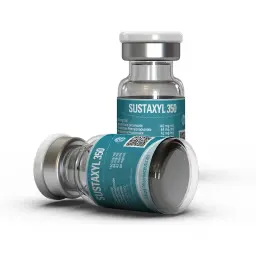


Drug Class: Growth Hormone Secretagogue
Composition: GHRP-6
Dosage: 10 mg/vial
Form: Lyophilized Powder
Unit: 2 mL Vial
Brand: Peptide Hubs
For Research Use Only
For bodybuilders and athletes engaged in demanding mass-gaining phases, consuming sufficient calories is often the greatest barrier to growth. GHRP-6 (Growth Hormone Releasing Peptide-6) is a pioneering synthetic peptide that provides a powerful two-fold solution: it potently stimulates the body's own Growth Hormone (GH) production while simultaneously inducing a significant increase in appetite. Sourced from Peptide Hubs in a high-capacity 10 mg vial of pure lyophilized powder, GHRP-6 is the ideal research compound for those looking to push through plateaus and achieve new levels of size and strength.
GHRP-6 is a first-in-class Growth Hormone Releasing Peptide, a hexapeptide that acts as a potent ghrelin receptor (GHSR-1a) agonist. It functions by mimicking the body's natural hunger hormone, ghrelin, sending a powerful signal to the pituitary gland to release a burst of endogenous Growth Hormone. What sets GHRP-6 apart from other secretagogues is its pronounced effect on hunger. This dual-action mechanism makes it a unique tool for research. A seminal study on PubMed demonstrated its potent GH-releasing effects in humans, establishing its foundational role in peptide research. By elevating GH levels through a natural pulsatile pattern, GHRP-6 offers a physiological approach to enhancing anabolism.
The effects of GHRP-6 are both rapid and profound, making it a favorite for bulking and recovery research:
For research purposes, GHRP-6 is administered via subcutaneous injection. With a half-life of approximately 15-30 minutes, it is typically administered 2-3 times per day to mimic natural GH pulses. Common research dosages range from 100 mcg to 300 mcg per injection. A standard and highly effective protocol is 200 mcg, taken 2-3 times daily. The high-capacity 10 mg vial from Peptide Hubs is perfectly suited for this frequent dosing schedule, providing a long-lasting supply. Critical to its efficacy is timing: injections must be performed on an empty stomach, ideally 2-3 hours after a meal and at least 30-60 minutes before eating, as food intake can severely blunt the GH response. Reconstitution with Bacteriostatic Water is required for use.
GHRP-6 cycles are typically long-term, ranging from 3 to 6 months, to allow for cumulative benefits in muscle mass and recovery. A break of 4-6 weeks is recommended after a long cycle to prevent receptor desensitization. GHRP-6 is famously synergistic with Growth Hormone-Releasing Hormones (GHRHs). For a powerful mass-building and recovery stack, consider combining Peptide Hubs GHRP-6 with:
GHRP-6 is well-tolerated by most research subjects, but its mechanism of action produces predictable side effects. The most common and pronounced is a significant increase in appetite. Some users may experience mild water retention, particularly at higher doses. Unlike its analogue GHRP-2, GHRP-6 has a slightly higher tendency to cause transient increases in cortisol and prolactin, though these are typically mild and subside with continued use. A tingling sensation or mild numbness in the hands (carpal tunnel-like symptoms) can occur due to fluid shifts and is a sign of strong GH activity. There is no evidence of HPTA suppression, liver toxicity, or estrogenic side effects. As always, product purity is paramount, which is guaranteed when you source from Peptide Hubs.
This is a critical distinction for researchers. While both are potent GH secretagogues, GHRP-6 induces a much more powerful hunger response. This makes GHRP-6 the superior choice for bulking phases where calorie consumption is a priority. GHRP-2, with its milder effect on appetite, is often preferred during cutting or recomposition phases. GHRP-6 is also considered slightly less potent for pure GH release per microgram compared to GHRP-2, but its ability to drive caloric intake often leads to superior mass gains in practice.
GHRP-6 remains an unparalleled research peptide for anyone studying mass accretion, appetite regulation, and enhanced recovery. Its unique ability to simultaneously elevate Growth Hormone and drive caloric intake solves two major challenges for growing athletes at once. When you decide to buy GHRP-6 USA, the quality of your source is critical. Peptide Hubs GHRP-6 is produced under strict quality control, with every 10 mg vial verified for purity and concentration, ensuring your research is built on a foundation of reliability and precision.
Name: Growth Hormone Releasing Peptide-6
Drug Class: Growth Hormone Secretagogue (GHS)
Other common names and terms: GHRP-6
Active Life: 15-30 minutes
Detection Time: Not well established; presumed short due to peptide nature
Chemical Structure: His-D-Trp-Ala-Trp-D-Phe-Lys-NH2 (a synthetic hexapeptide)
Common Doses: 100-300 mcg, 2-3 times daily (for research purposes)
Blood pressure: Can cause a transient slight increase
Acne: Rare, possible due to increased IGF-1
Water retention: Possible, usually mild
Aromatisation: Does not aromatize
Liver toxicity: None reported
Decrease HPTA function: No evidence of HPTA suppression
The hunger induced by GHRP-6 is often described as intense and can be overwhelming for some. It typically begins 15-30 minutes post-injection and can last for 1-2 hours. This effect is a direct result of its mechanism as a ghrelin mimetic. Researchers should be prepared for this and have healthy, high-protein meals ready to capitalize on this anabolic window.
For pure mass-building and bulking phases, GHRP-6 is often considered superior due to its powerful appetite-stimulating effect. The primary challenge in a bulk is consuming enough calories, and GHRP-6 directly addresses this. GHRP-2 is better suited for cutting or recomping phases where intense hunger would be a disadvantage.
Yes, indirectly. The significant increase in Growth Hormone and IGF-1 from GHRP-6 use creates a systemic environment that is highly conducive to healing and repair. For targeted injury recovery, it is best stacked with a dedicated healing peptide like BPC-157 or TB-500 for a comprehensive approach.
Injecting GHRP-6 after eating will significantly blunt its Growth Hormone-releasing effects. Elevated blood glucose and insulin levels from a meal suppress the pituitary's response to the peptide. The hunger effect will still be present, but the primary anabolic benefit of the GH pulse will be greatly diminished. Always administer on an empty stomach.
When you buy GHRP-6 USA from Peptide Hubs, you are choosing verified purity and accuracy. Our peptides undergo rigorous third-party testing, with Certificates of Analysis available to confirm that every 10 mg vial contains the exact concentration stated on the label. We are committed to supplying the research community with uncompromised quality, making us a trusted source for potent compounds like GHRP-6.
Please log in to write GHRP-6 10 mg review.

Drug Class: Growth Hormone Releasing Peptide
Composition: GHRP-6 10 mg
Dosage: 10 mg/vial
Form: Lyophilized Powder
Unit: 2 mL Vial
Brand: Dragon Pharma
For Subcutaneous Injection
Laboratory Test: View Lab Report

For Intramuscular Injection
Composition:
- Testosterone Propionate 42 mg
- Testosterone Phenylropionate 84 mg
- Testosterone Isocaproate 84 mg
- Testosterone Decanoate 140 mg
Mixed Dosage: 350 mg/1 mL
Unit: 10 mL Multidose Vial
Manufactured by Kalpa Pharmaceuticals